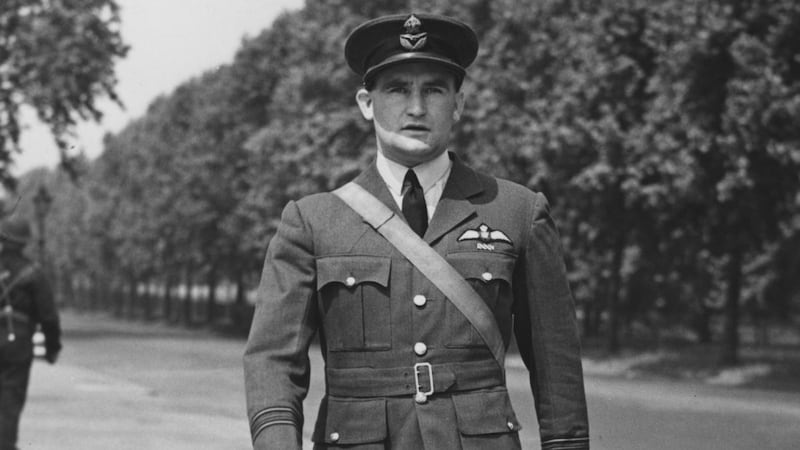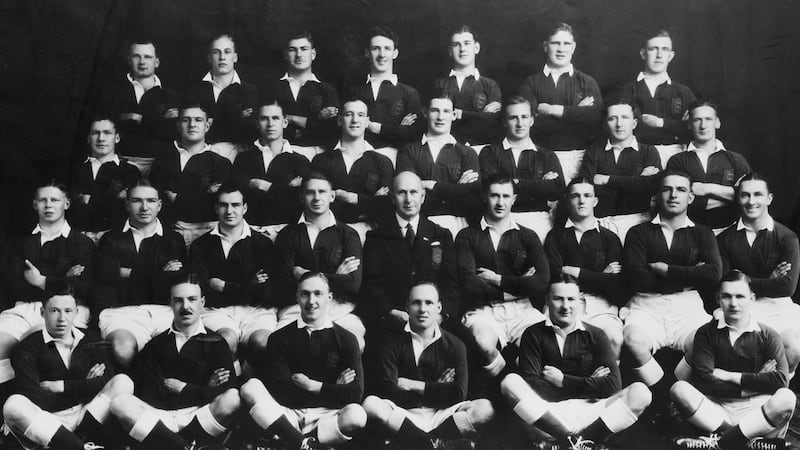From Dunmanway in West Cork to a knighthood, a rank of air marshal in the RAF and along the way a World War, 25 Irish caps and five caps with the Lions, George Beamish lived a cartoon-sized ‘Boys Own’ life.
It was a life that no rugby player today could have led, a life that would have been impossible during 30 years of the Troubles in Ireland and even in the years between the World Wars, where Corinthian ideals flourished, a life full of broad strokes and fantastically large horizons.
The life of George (1905-67) was also coloured by his siblings, Victor (1903-42), Charles (1908-84) and Cecil (1915-99), who like him were all accomplished sportsmen. George and Charles played international rugby for Ireland and with Victor and Cecil they all played variously with Leicester Tigers, London Irish and Harlequins.
A life that began in Dunmanway – the town of Sam Maguire 30 years before – George was part of the large Protestant community in the town. Still a child he, his brothers and two sisters, Katherine and Eileen, were led north by father Francis and mother Mary to school at Andrew Trimble’s old alma mater in Coleraine, where they were consumed by golf, rugby and the military.
They were all bewilderingly talented at a range of sports. Cecil came third among the amateurs when Max Faulkner won the British Open at Royal Portrush in 1952. George was a member in Portrush, while he, Cecil, Katherine and Eileen had all been club captain at the nearby links course at Castlerock.
They were all close friends of Fred Daly, who was the first Irishman to win the British Open in 1947. Daly grew up in the beloved Beamish heaven of the Portrush links.
Between them all the Beamish family provided one air marshal, one air vice-marshal, two group captains and two flight lieutenants. Victor even died a tragic, glorious death after an attack on his Spitfire by a Messerschmitt in 1942. As it says in ‘The Lion of the RAF’ by Paul McElhinney, it was “an impressive tally for one family.”
“Six siblings is still a record in the RAF,” says McElhinney. “George, Victor, Charles and Cecil and the two sisters. It’s also worth mentioning the four brothers also played for Leicester RFC and that was a record until the Tuilagi brothers recently had, I think, five or six brothers.”
The formidable sextuplet of Manu, Freddie, Henry, Alesana, Anitelea and Sanele Vavae Tuilagi, all Samoan internationals at Leicester, took the Beamish held record.
It was a different cultural world in Ireland in the years following the end of the War of Independence in 1921. While Beamish proudly called himself Irish, he had come from a world in which Britain had almost always featured as the governing nation. A true blue British officer, it was he who was credited in the 1930 Lions Tour to New Zealand of leading a delegation to management expressing their displeasure at the fact that the blue of Scotland, white of England and red of Wales were represented in the strip but there was no green for Ireland. A green flash was added to the socks.

According to ‘The Lion of the RAF’, 42,665 Irish citizens volunteered for service with the British armed forces in the second World War with other research putting the actual figure as high as 66,000.
There were clearly choices. Maguire, some years previously, went with the GAA and Irish nationalism, a choice that has earned him eternal fame with the senior All-Ireland football trophy named after him. But often those choices were governed by geography, religion, family associations and schooling.
“The original migration to Dunmanway was of Huguenots from Normandy,” says McElhinney. “What struck me as interesting was doctrinally they probably would have been closer to the Presbyterians because of the Calvinist streak. But they actually became Anglican, Church of Ireland, I think probably because they saw it being more advantageous to be associated with the C of I than with the Presbyterians.”
Because of the complexity of politics and allegiances and the hangover from the previous years of violence in Ireland, there was a ‘code of silence’ adopted for those in the British military living in the Republic of Ireland, although the Beamish family by then were long established in the north.
An economics and social studies graduate from Trinity College, Dublin, McElhinney previously worked in the Northern Ireland division of the Taoiseach’s office from 1980 until 1988. His mother’s family, the McDevitts, who were Catholics, came from Castlerock in Co Derry and were close friends with the Beamish family.
“I used to go up there every summer holidays so we knew the Beamish family and that sparked the interest,” he says. “I grew up a Catholic. But they were very good friends with the Beamishes who were C of I. That was quite normal for them so I could always steer a middle course myself.
“I knew the bones of it but through my research a lot of really interesting stuff came up that I didn’t know and that I set out in the book. It kind of unfolded as I went along.”
One glorious anomaly came to light after George joined the RAF college at Cranwell in 1923 as an 18-year-old. He would soon be a squadron leader and as officer class saw action in the Battle of Crete, the Desert War, the Sicily Campaign before becoming an aide-de-camp to the king.
All pretty impressive given he and his five siblings, all in the RAF during wartime, had a distant cousin Carin, who married Herman Göring, head of the German Luftwaffe. Carin, a great-great-granddaughter of the Beamish and Crawford brewery’s co-founder, William Beamish, became the first wife of Göring in 1923 but died prematurely from a heart attack in 1931 at just 43.
Hitler attended her funeral and in her memory, Göring named his estate outside Munich ‘Carinhall.’ Even in death she remained a mascot of the Nazis, while Göring had a room in his Berlin flat arranged as a shrine to her.

“I thought it was like a Monty Python joke and when I visited Cranwell I walked in and I saw this bust of Göring there in RAF Cranwell,” says McElhinney. “That itself . . . but I suppose the British are good at self effacing jokes.”
George played at number eight and won his first Irish cap as a 19-year-old in 1925 and between 1928 and 1933 was rarely out of the Irish squad. Selected in 1930 for the Lions’ tour of Australia and New Zealand, he played in all five Tests and in 17 of the regional matches. On return from that tour in the same year he was picked as Irish captain.
“I think the Irish captaincy was on the strength of his performance on the 1930 tour to NZ and Australia,” says McElhinney. “He definitely left a mark. He was like Donal Lenihan, the captain of the midweek side. I think that would have been the main reason. Also he captained an historic side that beat the Springboks in Leicestershire.
“Maybe it was just Ulster’s turn that year and they put their fellow forward, who knows? That’s just speculation. I prefer to think he was picked on the basis of his performance and talent.”
As McElhinney points out, Beamish was the only serving officer to captain the Irish rugby team until Ciarán Fitzgerald did so 50 years later in 1982. The important historical distinction being Fitzgerald, who led the Irish team to their first Triple Crown since 1949, was an officer in an altogether different army.
The forward in the book is by a more recent Ireland and Lions captain, Willie John McBride, who worked in the bank in Coleraine and knew George Beamish, who had settled in retirement back in Derry’s Castlerock. McBride spoke to him before going on the 1966 tour to Australia and New Zealand, which was McBride’s second of five Lions tours.
“I was lucky to get Willie John McBride to write the forward. He actually knew George,” says McElhinney. “He was sort of a mentor to Willie John. They lived not too far from each other when I think Willie John was working in the bank. Castlerock is just down the road from Coleraine. He spoke to George before he went on the 1966 tour but Willie John didn’t captain that one.
“It wasn’t until 1974. At the time Willie John was about 26 years of age. You can imagine a man of 60 and a 26-year-old. There was a certain kind of reverence and respect there towards George Beamish.”
Another to die for anomaly described fully in the book arose in 1959, when the retired George was approached by the Ulster Unionist Party to run in the Westminster elections following the deselection of the Ulster Unionist MP for North Belfast, H Montgomery Hyde.
Hyde had to go when he supported legislation to decriminalise homosexuality in the UK. But whispers at the time was that in the eyes of Ulster Unionists Hyde had adopted an even more treasonous position. Looking back, the question now is what on earth was he thinking when he purportedly cast doubt on the sexual orientation of King William of Orange.
Beamish like the former Ireland and Lions player and co-founder of the SAS, Blair “Paddy” Mayne, who came from Newtownards and earned his first Irish cap in 1937, four years after the last for Beamish, lived in different worlds. Sir George Beamish was a career British officer bound by sense of duty and service to Mayne’s derring do and cavalier bravery.
Like flying Spitfires and RAF air marshal’s playing rugby for Ireland, it is part of a past unlikely to be seen again.
The Lion of the RAF: The Extraordinary Life of George Beamish, second World War hero and rugby star by Paul McElhinney (£20) can be bought at all good bookshops from September 15th as well as www.amberley-books.com



















